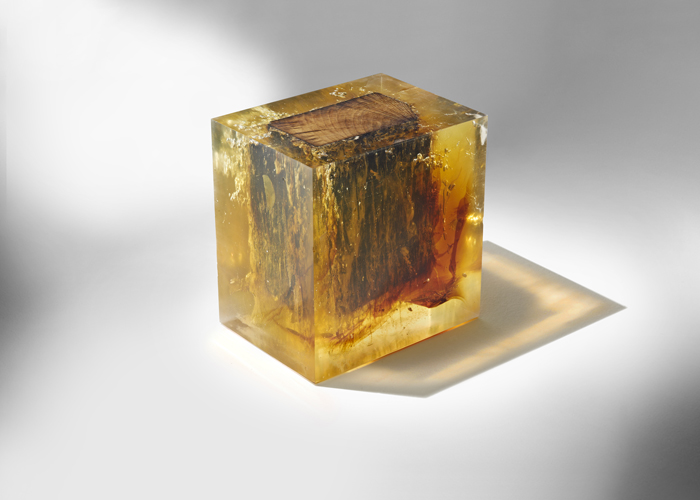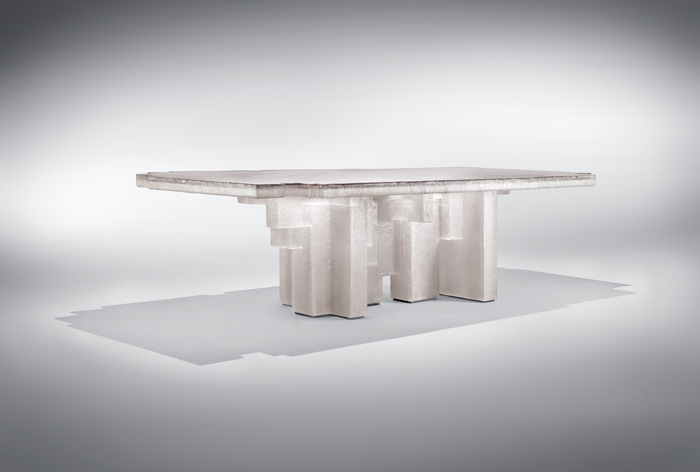Caitlin Diaz: Where and when was Nucleo brought into existence?
Nucleo: Nucleo was born 15 years ago, in Turin, as a collective from a heterogeneous group of people: photographers, artists, architects, industrial designers and graphic designers.
Nucleo is now a design studio based in Torino, Italy. The collective is active in contemporary art, design and architectural fields.
CD: What was the overall design aesthetic and philosophy?
N: The work of Nucleo consists of innovative, unique objects longing to continue the tradition of Italian artists. The pieces are an intensified investigation about human beings and the exploration of space and time – past, present, and future. Our handmade objects are collectively made, shared, and discussed.
Each artwork is original, made entirely by hand. Crafted without the use of molds, the finished pieces reveal signs of imperfections, making them one-of-a-kind and unrepeatable. Our designs are a composite of new and up-cycled materials.
CD: What changes, material or conceptual, has the studio experienced through the years?
N: Over the past 15 years a lot has changed. Projects have been born as a result of consequences. The most radical change has been the starting points for our new projects. We continue to research errors made in our past work and let them influence us; a drop of color that falls to the floor and explodes, or the fear that arises when something turns out not as we planned.
The origination of new work comes from “errors” and so-called negative emotions, like ‘fear,’ that come about while making the work.
CD: What is Nucleo working on at the moment?
N: Investigating the themes central to human life: love, fear, family, work, religion, politics, sex – Nucleo is working on a new project, a mirror of our society. Using a series of histograms, statistics, and a control group, Nucleo will make its first attempt at an open-loop collaboration. The final design will be presented at Design Miami at Art Basel.
We are also researching our first two-dimensional process. Using laser engraving we are exploring the usage and formation of “lines.” Lines as graphics without color, lines as the traces left by moving points, and lines as tension.
CD: At Design Miami last December. The Resin Fossil Table was the highlight of my experience. What inspired its creation?
N: The idea behind the Resin Fossil Table is the ever-present presumption that the future of our designs will be fossils themselves. Resin is a “materic” trace, where we find an imprint of the original item, in the same way that the implementation of the process that creates the object leads to the destruction of the original. The table consists of a single empty block that accurately traces the object from which it takes shape.
CD: I reviewed the making-of photos on your website, the process is fascinating! Could you elaborate more about the process and what makes it so unique?
N: The making becomes so unique because it is obtained through a destruction process. First, we made a true-scale model of the table in polystyrene. This model became the mold of the resin table. The model was covered with resin and fiberglass. When the resin became strong enough, the model was destroyed using a solvent. That definitely makes it a unique piece.
CD: I also loved how, when lit properly, the table looks like a glowing, frosted artifact that could exist somewhere in the Arctic. How does lighting affect your designs, in particular The Resin Fossil Table? Do you experiment with different methods of presentation? Ideally, where would this table live?
N: Really, I never imagined the Resin Fossil Table in the Arctic, because the inspiration was the fossil. But you aren’t the first to have said that it looks like frosted ice. But, of course, one of my secret dreams is to design the ice hotel in Sweden.
Light and shadow play an important role in our pieces. Light plays with transparency and reflection while shadow defines volume and density. Though we rarely use lights inside our objects. Playing with different thicknesses between the top of the table and the sides produces the effects of light. The top is more transparent than the sides, which allows the light to run through the table and glow from all angles.
Ideally, the table would live in Brazil in a concrete house of Oscar Niemeyer.
CD: What appeals to me about the Wood Fossil pieces is the relationship between preservation and mystery. What was the first piece from this series and what influenced the creation of the following pieces? Where is the wood sourced from and is there a significance about their origins? Would you say these pieces take discarded, yet loaded, information (the wood) and encapsulate them to preserve their meaning?
N: Since I was a child I was fascinated with fossils. I loved the insects that were encapsulated in the resin. With resin we started thinking about fossilization, with wood, we open ourselves to the amber chapter.
What is impressive about fossils is that they are like a time machine; the inclusion in the resin makes the fossil eternal. On one hand, it is a great responsibility. On the other hand, it is the relation between people 1000 years from now that will find our work.
The first objects of the Wood Fossil Series are single pieces of wood encased in a block of epoxy resin. The wood is up-cycled, found in an old storage timber. The block of resin keeps the relationship alive with the dissolving piece of wood; it is a game of presence and absence, lightness and weight, challenging the laws of gravity.
The type of wood used in making the Wood Fossil’s isn’t important. The fact that it is a “souvenir of the last century” is crucial. It is a collection of memories, up-cycled into new forms. The souvenir as an evidence of memories, the souvenir as a gift for those who were not there, the souvenir as a triumph of life experienced.
Nucleo explores materiality and experiences as well as points of reference, fragile, lost, and strong. The memories of the past century have been re-found through discarded materials marked from an era. Full of scars, the material holds stronger characteristics than when it was new.
Nucleo has restored and preserved memories, mummifying fragments of the past, mixed up with physical presence, and their contemporary existence. By creating “souvenirs of the last century,” Nucleo’s objects are innately designed for the future.

























